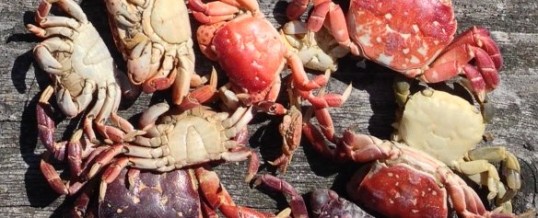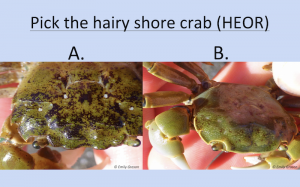
May 11, 2018
HEOR or HENU? Crab Team volunteers know it’s one of the most challenging questions we face during sampling. Telling hairy shore crabs (HEOR) apart from purple shore crabs (HENU) can be very tricky, especially when all you have is two tiny molted carapaces. It’s not only shore crabs; several groups of crabs can be tricky to distinguish from each other, even if you know what you are looking for.
As you learn a new set of species, whether it’s birds, or crabs, or lichens, each species starts off as just a list of features: number of spines, shape of shell, etc. But, as you see more and more, and get faster at identifying them, you start to develop a “gestalt” for each species. The whole impression of the critter becomes a mental shortcut for that list of features. Your brain knows that it’s a HENU before it knows why it’s a HENU!
Transitioning from features to gestalt takes time and experience – and patience! You need to see LOTS of examples of each species, and comparisons, to develop a sense about how much variation in color, or size, or shape, etc, there is within each species, and which features are always different between similar species. This is why field guides can only go so far in helping you become proficient at quickly identifying things. When working in the field, you don’t always have the luxury of getting ahold of other species for simultaneous comparison.

Sample ID Flashcard focusing on picking the hairy shore crab (HEOR). Bonus points if you can tell what species the other crab is! (Click to enlarge)
With this challenge in mind, we created a set of flashcards to help our volunteers practice this skill on the set of crabs most commonly encountered in our monitoring. This is based on the Snap ID tool used by the Cornell Lab of Ornithology’s Bird Academy (thanks for the inspiration!). These flashcards are designed to practice ID and develop a gestalt. In each deck, you are looking for only one species in multiple comparisons of similar-looking species. This works in two ways – first, by looking at similar species side by side, you can directly compare the relevant features. Second, by moving through several successive comparisons looking for only a single species, you can start to develop a search image for that particular species. Looking at many different photos and images of your target crab species, your brain has to focus on the relevant parts of the crab to develop that overall image, rather than the single pattern for a particular photograph.
We’re happy to share this resource with you. We’ve created decks of cards for the most commonly confused species, as well as one for European green crab (CAMA) compared to every other native crab that you are likely to encounter in sampling. You can print them out or just download the PDF and scroll through, quizzing yourself as you go. We’ll try to add to these as we have the opportunity. Though we don’t currently have the technical capacity to put this in an interactive tool on our webpage, that could be something we shoot for in the future.
The Tricky ID Flashcard decks can be accessed on the Volunteer Toolbox page, in the Learning Resources section on the Identification tab.
For more HEOR vs HENU comparisons specifically, check out these additional resources:
-Emily Grason
MAY
2018